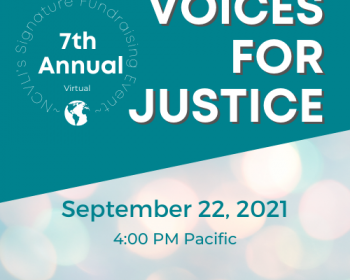NAVRA Member Profile: Crime Victim Advocacy Center of Tulare County - Amy Terrible and Layli Caborn
Open gallery

Crime Victim Advocacy Center of Tulare County: Amy Terrible and Layli Caborn
Amy Terrible and Layli Caborn are victims’ rights lawyers and National Alliance of Victims’ Rights Attorneys (NAVRA) members who represent victims of crime in Central California. This March they will launch a nonprofit organization to grow their work for victims, the Crime Victim Advocacy Center of Tulare County, California.
Both former prosecutors, Amy and Layli eventually realized that their true passions lay with achieving justice for victims and they felt that they could do that better by directly representing victims. We took some time to talk with Amy and Layli about their work.

As a prosecutor, Amy worked on involuntary civil commitment cases which meant that she was afforded a great deal of contact and flexibility with many victims. One case involving the prosecution of a man who had sexually victimized his younger brother as a child was particularly moving for her. By the time of the trial, the victim was incarcerated and the prosecutor’s office chose not to have him testify or attend trial. This meant that he never had a chance to say in court what happened to him. But Amy went to the prison where the victim was incarcerated to talk with him. “I told him I wasn’t there to talk about why he got locked up, I was there because he was a victim and never got to take the stand and talk about what happened to him. I told him that if he wanted that opportunity, I was there to give it to him.” In this moment she saw how much it meant to him that someone wanted to hear his story and realized how many victims never get to be heard, and still carry that burden with them every day. “It was like he was back in his childhood and someone said to him “your voice is really going to be heard now.” She says this was the most pivotal moment in her career.
Layli’s work with victims goes back to before law school when she did an internship with the Ventura County District Attorneys’ office as a case worker with the victim advocate. She worked with domestic violence and child abuse victims and swore she would never go to law school after observing the lack of justice experienced by victims. “Victims seemed to just be tools in the prosecutor’s toolbox to get what prosecutors needed to get achieved.” But eventually Layli found herself in law school and then as a prosecutor. Again, she felt disillusioned by the mistreatment of victims in the system. “I couldn’t stand to see what was happening to victims,” she says. “So much of the time, there wasn’t a single thing I could do to help victims I was working with. Being a prosecutor, my hands were tied; victims were a piece of evidence.” When she was preparing to return to work after maternity leave, Amy invited her to join her in building a practice exclusively for victims and says “I joined as fast as possible!”

Amy and Layli heard about NCVLI’s work before they made the decision to become victim attorneys. For Amy, a co-worker at the prosecutor’s office where she worked went to an NCVLI training and came back talking about rights enforcement work. “At first I didn’t get it,” says Amy. “I said that’s what I do at the prosecutor’s office.” Over time she learned more about victims’ rights and realized that direct representation of victims is what she wanted to do. “I went on NCVLI’s site to find any resource I could find… and ended up finding out about an upcoming NCVLI training in California.” Amy attended NCVLI/NAVRA’s “The ABC’s of Representing Victims of Crime” at Stanford University Law School in the spring of 2012 and met NCVLI attorneys as well as other practitioners in the field. From there, things just fell into place. Within weeks Amy had given notice at her job and set out on her path to build a practice exclusively representing victims of crime.
Since June of 2012 Amy has been operating as a solo practitioner representing victims of crime, entirely pro bono. She has worked on a range of cases from representation of the surviving family of a murder victim, to a complex case involving multiple jurisdictions in the theft of a car across state lines, to stepping in as the attorney for a child-victim in family court, to representation of domestic violence victims. Layli joined in October when Amy decided to expand services to reach more victims.
Next month the Crime Victim Advocacy Center of Tulare County will officially launch, providing free services to victims including legal representation, information, advocacy, and support in navigating the criminal justice system.
So far, education and relationship building have played a critical role in the development of their organization. “This is a small county and you work with the same people over and over again; you have to have good relationships,” says Amy. Maintaining good relationships can be tricky when part of their work also involves persuading people in the criminal justice system about the importance of their role as victim attorneys. “We get push back from the very offices we need to work most closely with because they don’t understand where we fit,” says Amy. But they know that working through that push back skillfully is how they will change the culture of the criminal justice system for victims. “We’ve been scheduling trainings to explain who we are and what our role is.” They’ve also appeared in courts where judges and defense attorneys have never seen victim lawyers. They have had both victories and losses, but it is all a success in that they are getting courts comfortable with victim attorneys.
Partnering with NCVLI
Amy and Layli are up against a lot, as they are the first to be doing victim representation in Central California. “There have been several days when I wanted to shut it down, through tears,” admits Amy. NCVLI and NAVRA have been invaluable in supporting their practice and making them feel less isolated. “Every step of the way I’ve been calling NCVLI. There’s nobody here for me to go to, no one across the street for me to ask how to file a motion. This is all brand new here.”
The first source they go to when conducting legal research is the NAVRA website with its database of victims’ rights related briefs, case summaries, and sample pleadings. “I would be trying to create everything from scratch,” says Amy, “but NAVRA has the research separated out by topic so it’s easy to find recent cases.” NAVRA’s national network of attorneys has also been useful to their practice. They recently participated in a call organized by NCVLI/NAVRA that involved victim attorneys from across the country. Practitioners shared resources, best practices, challenges, and successes. “Things like this have taken me off what feels like an island and allowed me to branch out,” says Amy. They plan to attend NCVLI’s 12th Annual Crime Victim Law Conference in June in Portland, Oregon to meet colleagues from around the country in person and learn from the leading experts in the field.
The future of justice for victims
Amy and Layli want to see equal justice for victims. California has strong laws for victims with the 2008 passage of Marsy’s Law (a constitutional amendment for victims), and they want to see it more consistently enforced. “We want to see scales equaled out. We want the whole system to take notice of victims; to realize that they can’t run all over the victims; that the victim has a voice and can be heard.”
Watch for the Crime Victim Advocacy Center of Tulare County at www.cvactc.org.
The website will launch April 1, 2013.
To learn more about NAVRA, visit www.navra.org

